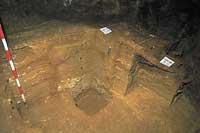Studying the geology of Atapuerca
The UPV doctor and professor of the Department of Geology, Arantxa Aranburu, is trying to discover the intricacies of history in Atapuerca, under the direction of Juan Luis Arsuaga.
The main objective of the project is to know what happened during the Pleistocene, including the research of geology. In addition, geology also has a second function: helping in bone dating.
Geology of the Sima de los Huesos
The cave called Sima de los Huesos is located in the karst system of Atapuerca. The karst is a network of dissolving holes that generates water in limestone or other rocks. What is in Atapuerca extends along three kilometers to different levels and is considering investigating its geological history.

The well-known Sima de los Huesos is a narrow gallery of 30 m deep in which the greatest accumulation of human bones has been discovered to date. Geologically speaking, it is a cave with several sedimentary fillings, whose research has shown that the history of the karst system is complex. The karst had four stages: the first of its creation, the second of its fulfillment, the third of its partial emptying and the fourth of its partial replenishment. In this last stage are the human bones and bears of the bears found in the Sima de los Huesos.
Following the principles of geology, over the years deposits accumulate over each other. For this reason, in the Sima de los Huesos, several bones have been found in which the upper and lower layers of the bones can be studied to help date them.
Although they were old, they are even older
In the gallery, during a ground cut, a speleotema was discovered on the bones of the Homo heidelbergensis, ancestors of the Neanderthal. The speleotema is a precipitate of carbonate, that is, the same material as the stalactites and stalagmites. In this case, instead of having column shape, it is a speleotema in the form of a layer, which also does not contain sediments. After the extraction of some fragments of the speleotema, they were analyzed by a team specialized in dating. Geochronologists demonstrated the purity of the sample and dated it by disintegrating uranium/thorium.
Dating has shown that speleotopic is older than previously thought, meaning that the bones of Homo heidelbergensis found under speleotopic are older than that age. So far, bones were considered between 200,000 and 320,000 years, based on the ESR method performed on paleomagnetism, U-series and bones, but they were not fine dating. The latest speleotopic dating has shown that the bones of Homo heidelbergensis are over 350,000 years old.
After this extraordinary discovery, there are still unanswered questions and geologists have already launched them. One of the closest objectives is to discover where human beings entered the Sima de los Huesos and then who knows with what other discoveries will be found along the roads of Atapuerca.
Project title: Geological, BXX2000 1258-C03-02
|
Objective:Study of the |
Director: |
Working group: Juan |
Category: |
Buletina
Bidali zure helbide elektronikoa eta jaso asteroko buletina zure sarrera-ontzian











